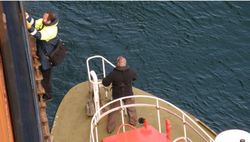Keeping marine pilots safe

Ships across the globe continue to regularly provide substandard or badly rigged ladders, which means pilots face a big moment of risk every time they use these to board vessels, especially in parts of the world not renowned for good health and safety.
The close of Seafarers Awareness Week is an opportunity to raise awareness around the dangers pilots face every day of the week as they transfer to and from the vessels that they are tasked with assisting
MOST PILOT EMBARKATIONS AND DISEMBARKATIONS AROUND THE WORLD ARE STILL CARRIED OUT USING A TRADITIONAL PILOT LADDER.
WITH the recent attention of the global maritime industry firmly directed to environmental issues, and the ever moving political and trade climate, you could easily overlook maritime safety issues.
But as UK Seafarers Awareness Week draws to a close, we should take the opportunity to promote the good things the maritime industry has achieved in terms of safety, but also to highlight that there are still challenges we need to overcome.
A continuing challenge is the sometimes difficult process for pilots to transfer to and from the vessels that they are tasked with assisting. Most pilot embarkations and disembarkations around the world are still carried out using a traditional pilot ladder, consisting of wooden steps supported and secured by side ropes.
Following a number of fatal accidents, the International Maritime Organization updated the Safety of Life at Sea Convention — Solas V Regulation 23 — over a decade ago. That includes minimum requirements on pilot ladder arrangements and compliance as legal obligations, not just an aspiration.
Despite the rules, regular issues with defective pilot ladders remain. Results from recent surveys carried out by the International Maritime Pilots’ Association and, separately, the British Ports Association, continue to show that a considerable number of Pilot Transfer Arrangements are not compliant with legislation.
The reasons for this are many and varied. A contributory factor includes a lack of understanding of the regulations due to an educational gap, which leads to a subsequent lack of knowledge and the core seamanship skills required.
The last three annual IMPA safety campaigns revealed that while identifications of defective pilot ladders have decreased as a proportion of all pilot ladder inspections, the actual number of incidents has not been falling. Such ladder deficiencies pose a risk of serious harm or even fatal injury to pilots.
Further to this, results from the IMPA surveys and other similar initiatives consistently record that approximately 20% of pilot transfer arrangements presented are non-compliant. This figure, which is potentially underestimated, means that at least one pilot ladder in every five offered is putting a pilot’s safety at risk. This is simply not acceptable.
Many ports now require a pre-arrival declaration that ‘Pilot transfer arrangements comply with the IMO’s requirements’. This declaration may be requested either verbally by radio or as part of a written statement. Where a vessel is found not to have a compliant pilot ladder, it may be denied entry by the port until the situation is rectified, potentially causing a significant financial cost to the shipowner.
On occasions, masters commonly suggest ‘it’s always been like that’ or ‘we’ve never had a complaint before’, or produce a certificate stating that the arrangement is ‘class approved’.
However, with better understanding, pilots are now more likely to challenge these statements and highlight that class approval does not necessarily indicate compliance.
The UK shipping industry has worked hard to improve safe practices on board British ships.